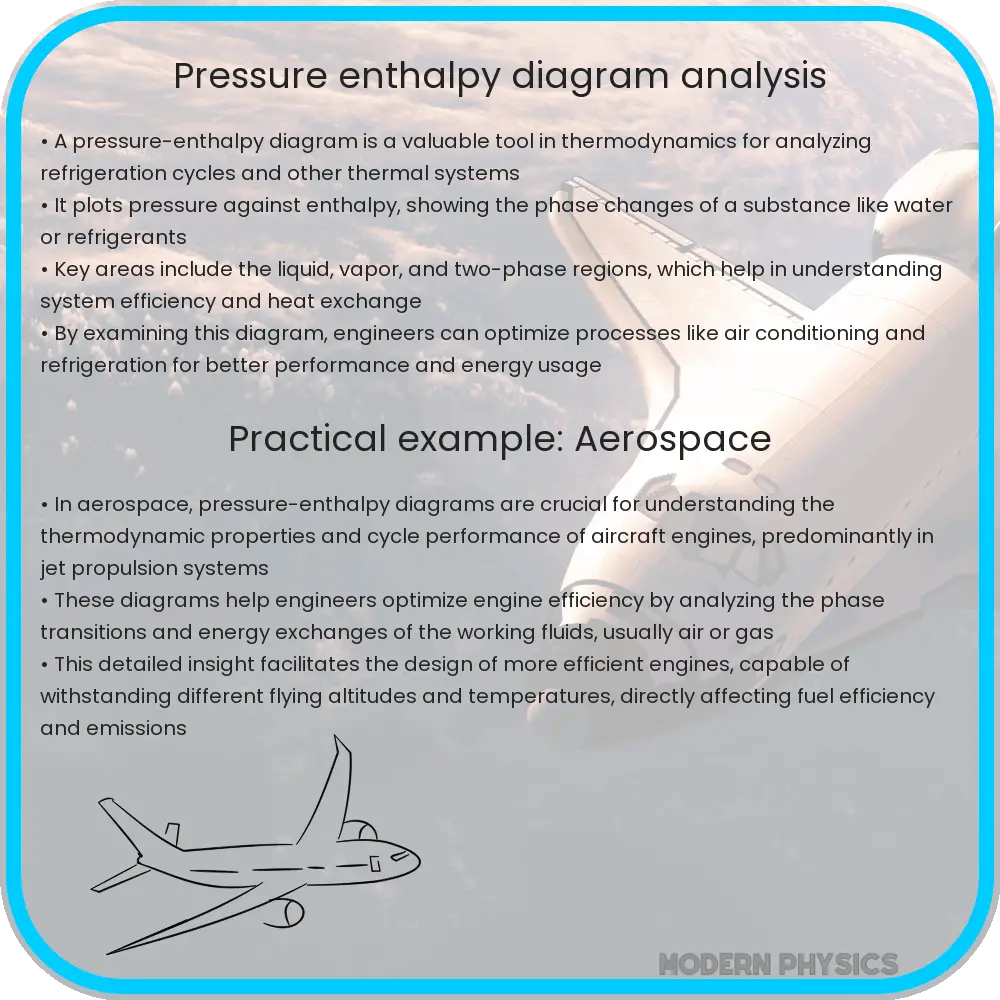Learn how the Pressure-Enthalpy Diagram is crucial for analyzing and optimizing HVAC and refrigeration systems by mapping enthalpy against pressure.

Understanding the Pressure-Enthalpy Diagram
A Pressure-Enthalpy (P-H) Diagram is a valuable tool used in thermodynamics to analyze and optimize refrigeration cycles. This diagram plots the enthalpy of a system as a function of its pressure, providing critical insights into the performance and efficiency of HVAC (Heating, Ventilation, and Air Conditioning) and other refrigeration systems.
Components of the Pressure-Enthalpy Diagram
The P-H diagram consists of several key components, each representing different physical and thermodynamic properties:
- Pressure Axis: The vertical axis of the P-H diagram represents the pressure of the refrigerant. It is usually logged to accommodate the wide range of pressures in a refrigeration system.
- Enthalpy Axis: The horizontal axis shows the enthalpy, which is a measure of the total energy of the refrigerant, including both its internal energy and the energy associated with its pressure and volume.
- Constant Temperature Lines: These lines, known as isotherms, run diagonally from the lower left to the upper right, indicating constant temperature.
- Constant Entropy Lines: Also called isentropic lines, these curve across the P-H diagram, depicting entropy changes within the system.
- Saturation Curve: This bell-shaped curve divides the diagram into two regions – the left side under the curve shows where the refrigerant is in a liquid state, and the right side indicates where it is in a gaseous state. The very top of the curve is the critical point where the liquid and vapor properties become indistinguishable.
Analyzing Refrigeration Cycles
In the context of refrigeration cycles, the P-H diagram provides vital information that helps in understanding the efficiency and operation of the system. The cycle typically starts at the bottom of the saturation curve where the refrigerant is in a fully liquid state. As it moves through various components of the system like compressors, condensers, expansion valves, and evaporators, its state changes as indicated by movements across the diagram:
- Compression: Starting from the lower left region (wet or mixed region) moving vertically upwards, reflecting an increase in pressure and enthalpy as the refrigerant is compressed.
- Condensation: The high-pressure vapour then moves horizontally left towards the saturation curve, releasing heat and changing phase from vapor to liquid.
- Expansion: This involves the refrigerant passing through an expansion valve, moving horizontally right due to a drop in pressure and enthalpy without heat exchange.
- Evaporation: Finally, the refrigerant absorbs heat and moves back to the bottom of the saturation curve, completing the cycle.
Each point on the P-H diagram during the cycle can be used to evaluate the energy interactions, and hence the overall performance of the refrigeration system. By studying these interactions, engineers can make informed decisions on optimizing the system components for better efficiency and cost-effectiveness.
Practical Applications of the P-H Diagram
The Pressure-Enthalpy diagram is not only a theoretical tool but also has practical applications in various industries. For instance, in the HVAC industry, engineers use the P-H diagram to design systems that optimize energy consumption while maintaining the desired indoor air quality and comfort levels. It helps in selecting the appropriate refrigerants and in determining the optimal operating conditions for compressors and other components.
Moreover, the P-H diagram is instrumental in troubleshooting refrigeration systems. By analyzing the changes in enthalpy and pressure, technicians can identify issues such as refrigerant leaks, inefficiencies in the compressor, or blockages in the system. This diagnostic capability makes maintenance more effective and helps prevent system failures.
Educational Importance of P-H Diagrams
In educational settings, the P-H diagram serves as an essential learning tool for students studying thermodynamics, refrigeration, and HVAC systems. It provides a visual representation of how energy transformations and phase changes occur within a system, making abstract concepts more tangible. Universities and technical schools often incorporate P-H diagrams in their curricula to enhance students’ understanding and to equip them with practical skills for their future careers.
Furthermore, the diagram encourages analytical thinking and problem-solving skills, as students must interpret the diagram to predict system behavior under various conditions.
Conclusion
Understanding the Pressure-Enthalpy diagram is crucial for anyone involved in the design, operation, or maintenance of refrigeration and HVAC systems. This tool not only offers insights into the thermodynamic properties of refrigerants but also assists in optimizing system performance and troubleshooting. With its ability to illustrate complex processes in a comprehensible way, the P-H diagram bridges the gap between theoretical thermodynamics and practical engineering applications.
The knowledge of how to read and interpret a P-H diagram empowers engineers and technicians to make informed decisions that enhance system efficiency, sustainability, and reliability. As such, mastering this diagram is an invaluable skill in the fields of thermodynamics and refrigeration engineering.
